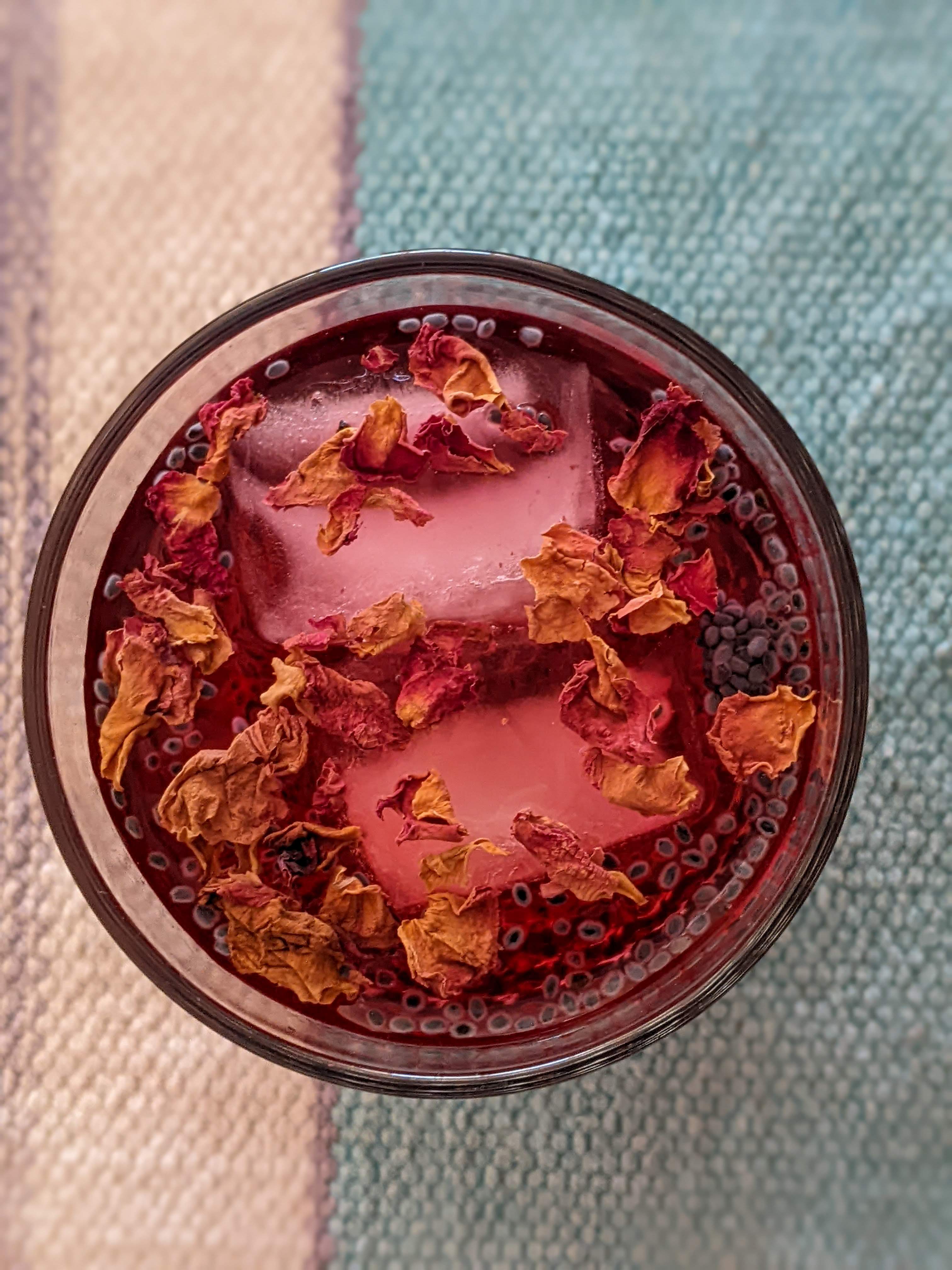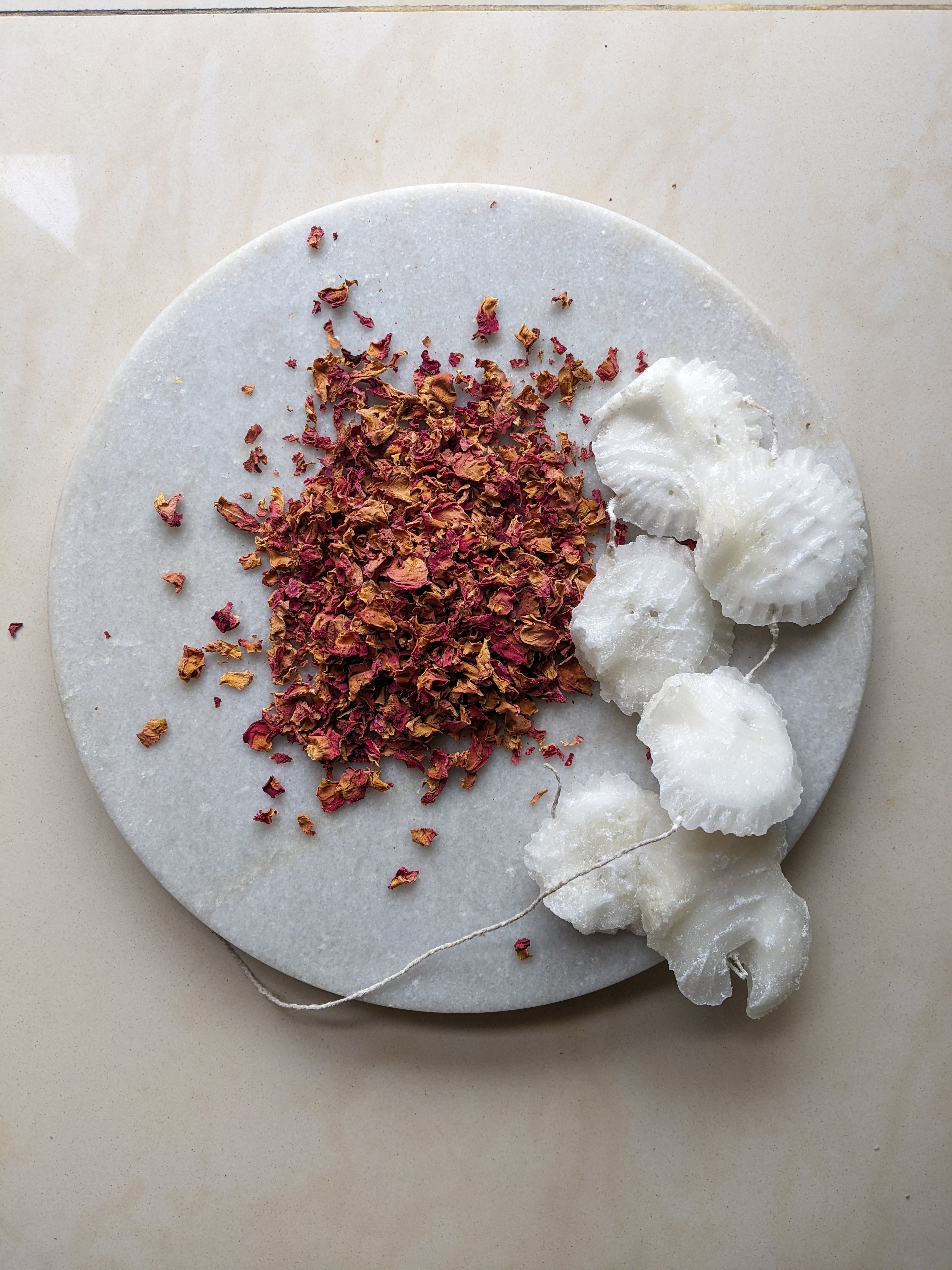Roses, to me, bring up the evocative, almost-dizzying scent of the inimitable desi gulab, the rosa damascena,a variety of the Damask rose. The heady oil of which dabbed upon my pulse points lulls me to luxurious sleep, the sweet petals of which I chew in my warm nightly haldi doodh with gulkand, the refreshing water of which wakes me the next morning with a spritz of arq-e-gulab.
It conjures no image of decorative flower arrangements but only of the various sensory pleasures it could provide – whether culinary or olfactory.
Flowers have been used for food and medicinal purposes since ancient times across Asia, Europe, Victorian England and of course, the Middle East. Edible flowers are not only in vogue now through the spreads of trendy food magazines but have been traditionally used to improve the aesthetic appearance and taste of food.
As the psychedelic pink hues of rose sherbet cool my water glass in the insufferable heat wave of the sub-continent, I’m amazed at the omnipresence of this romantic ingredient in my life. The thought transports me immediately to the most magical of preserves made with roses, evangelically cooked by the delicious heat of the streaming sunlight… dhoop – the Gul Kand.

An ancient, fabled preserve entrenched in the Ayurveda and Unani medicinal cannons – Gulkand is an enchantingly floral sweet preserve made by macerating the petals of delicate damask roses with rock sugar and letting it bask in the summer sun until it turns into an unctuous jam. In ancient India, rose petals were preserved in the form of Gulkand or fragrant Gulkand sharbat. Gulkand is what sweetens the meetha paan and forms the crown jewel in the repertoire of the various digestifs and mouth fresheners in it.
The canons proclaim these rose preparations as endlessly virtuous to human wellbeing – they seem to contain all manner of anti-bacterial, anti-oxidant and most interestingly perhaps - a hypnotic and relaxant effect - as part of its pharmacological properties. The rosa damascene is also a rich source of vital minerals like calcium, phosphorus, potassium, zinc, and iron. Entirely too easy to believe.
Gulkand is meant to cool our internal digestive systems, purify our blood, alleviate stress, fight fatigue, amongst other unbelievable feats.
For an Ayurvedic tonic, it is a singular joy to consume, in any form.
Perhaps the most beauteous part of it is the process of its making. Bashed rock sugar and freshly plucked, moist rose petals are layered in a clear glass jar and muddled together to release floral oils and flavours to form a sort of rose sugar. This scented blend of sugar then sits in glorious sunlight and cooks ever so gently, over the course of several weeks. Slowly releasing the moisture, the heady scent, flavour and oil of the roses, gently seeping through the sugar crystals. Flavours enmeshing and marrying.
The canons proclaim these rose preparations as endlessly virtuous to human wellbeing – they seem to contain all manner of anti-bacterial, anti-oxidant and most interestingly perhaps - a hypnotic and relaxant effect - as part of its pharmacological properties. The rosa damascene is also a rich source of vital minerals like calcium, phosphorus, potassium, zinc, and iron. Entirely too easy to believe.
Gulkand is meant to cool our internal digestive systems, purify our blood, alleviate stress, fight fatigue, amongst other unbelievable feats.
Its gentle floral scent somehow magically calms the nerves and cools off the body.
For an Ayurvedic tonic, it is a singular joy to consume, in any form.
Perhaps the most beauteous part of it is the process of its making. Bashed rock sugar and freshly plucked, moist rose petals are layered in a clear glass jar and muddled together to release floral oils and flavours to form a sort of rose sugar. This scented blend of sugar then sits in glorious sunlight and cooks ever so gently, over the course of several weeks. Slowly releasing the moisture, the heady scent, flavour and oil of the roses, gently seeping through the sugar crystals. Flavours enmeshing and marrying.

With little to no intervention, certainly no external heat source, the sugar slowly melts under the gaze of the sun, enveloping itself around the rose petals, preserving their inherent phyto-chemicals, nutritientson, fragrance and flavour.
Once ready, the Gulkand can be spooned and eaten on its own, stirred into water or milk. Warm in a cosy cup or cold as a dew drop. It has a coveted spot in spiced thandaai during Holi. It may be placed within a betel leaf for a refreshing meetha paan or incorporated into a most wonderful dessert, maybe a milk peda or sticky laddoo with dried fruit.
I speak from experience when I say that most delightful of sweets may be concocted by harnessing the flavour of the roses with the inherent floral sweetness of Gulkand. Its luxurious texture, scent and flavour unmatched by any manufactured jam.
Once ready, the Gulkand can be spooned and eaten on its own, stirred into water or milk. Warm in a cosy cup or cold as a dew drop. It has a coveted spot in spiced thandaai during Holi. It may be placed within a betel leaf for a refreshing meetha paan or incorporated into a most wonderful dessert, maybe a milk peda or sticky laddoo with dried fruit.
I speak from experience when I say that most delightful of sweets may be concocted by harnessing the flavour of the roses with the inherent floral sweetness of Gulkand. Its luxurious texture, scent and flavour unmatched by any manufactured jam.



